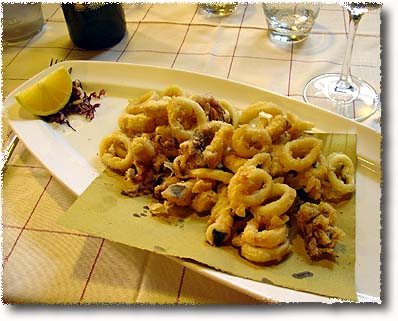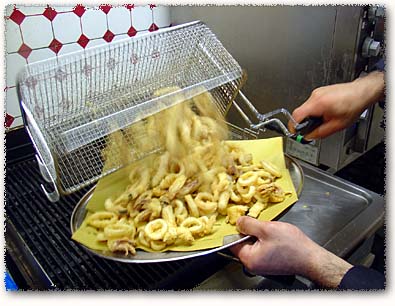Pellegrino Artusi, the great 19th century cookbook author, mentions Brodetto in passing in La Scienza in Cucina e L’Arte di Mangiar Bene, but not to give the recipe. Rather, he was peeved by the variability of the Italian spoken in his day:
“Cacciucco! Let me say something about this word, which is probably not understood except in Tuscany and along the Tyrrhenian coast, since the word brodetto takes its place in the towns along the Adriatic. In Florence, on the other hand, brodetto is an egg soup served at Easter, made by crumbling bread in broth and thickening the mixture with beaten eggs and lemon juice. The confusion between these and other similar sounding words from province to province in Italy is so bad that it wouldn’t take much to make a second Babel.
“Now that our country is unified, the unification of spoken Italian, which few promote and many hinder, perhaps because of misplaced pride, or perhaps because they are comfortable with their dialects, seems to me a logical consequence.”
He was of course right about the linguistic confusion; a study carried out in 1870 estimated that only 5% of the people then living in Italy spoke Italian — everyone else spoke dialect of one sort or another, and even today, with the unifying effects of television, you can meet people of the elder generation who are much more comfortable speaking what they spoke with their grandparents than they are speaking modern Italian.
And why, you wonder, doesn’t Artusi give a recipe for brodetto? He was after all from Romagna and grew up not far from the Adriatic. The answer, not to mince words, is that it was poor people’s food, what the fishermen made on the boats from fish with little market value, and their wives, who peddled the catch, made at home from what hadn’t sold, and Artusi was writing for a middle class audience that would have sneered at it (cacciucco enjoyed greater repute).
Times have changed, however, and now modern Italians who live along the Riviera Romagnola (the Adriatic coast north and south of Rimini) are developing an interest for the dish. Not that this makes finding a true brodetto in one of the Riviera’s many restaurants any easier, because true brodetto is shockingly simple, and restaurant cooks (and many home cooks) find the temptation to jazz it up irresistible.
Simply put, the first rule for making brodetto is that the fish must be absolutely fresh. Small, spiny, ugly, doesn’t matter — it has to be flavorful and fresh. Thawed won’t work, nor will something taken off the boat yesterday morning.
The second rule is that the fish should be local; the fish that go into brodetto vary from town to town along the Riviera Romagnola, but include (among others): Cuttlefish, gray mullet, reef mullet, mackerel, bogue, striped mullet, mantis shrimps (when in season, and some purists shudder at them), crabs, and sole. If possible the fish should be washed in sea water, but you should only do this if you know your water is uncontaminated.
Mussels and clams can go into a brodetto, but often do not (family members not on the boats or selling the fish used to gather clams on the beaches to make clam stew), while scampi and other more prized crustaceans would never have gone into a traditional brodetto — they’d have been sold.
Likewise, a traditional brodetto would not have contained anything exotic, or that had to be shipped in. One thing the fishing families did do to increase the flavor of their brodetto was to gather the heads of the fish they sold, boil them separately, and add the resulting rich broth to the brodetto pot.
Spicing and seasoning? It varied from town to town, but was simple, as the fishing families had to barter with farmers for herbs: Olive oil was a constant, and one could also find onions, garlic, parsley, vinegar (often substituted for by dry white wine), a little salt, and abundant freshly ground pepper. Tomato paste and tomato sauce (used sparingly) didn’t appear until the mid-late 1800s, and the use of hot pepper is even more recent.
Cooking vessels and times? Tradition dictates one use a low-sided broad round terracotta pot, and a gentle flame; Metal will of course also work, but will transmit the heat faster. As is the case with all mixed fish stews one adds the fish to the pot in succession, first the kinds that cook slowly and the larger pieces, and then smaller pieces and quickly cooking fish. Total cooking time will be a half hour or more.
Finally, serving: Romagnoli generally serve brodetto over slices of toasted bread that do a beautiful job of soaking up the drippings, and accompany it with Sangiovese di Romagna, a light lively red wine. The other option I might consider for a wine would be Trebbiano di Romagna, which is just as light and lively.
Some Recipes:









